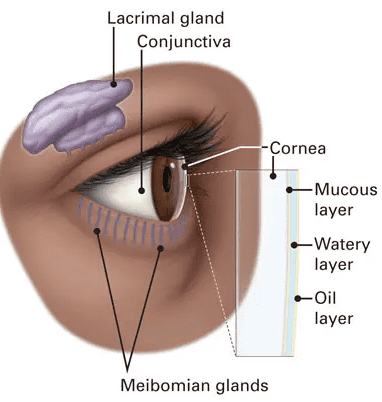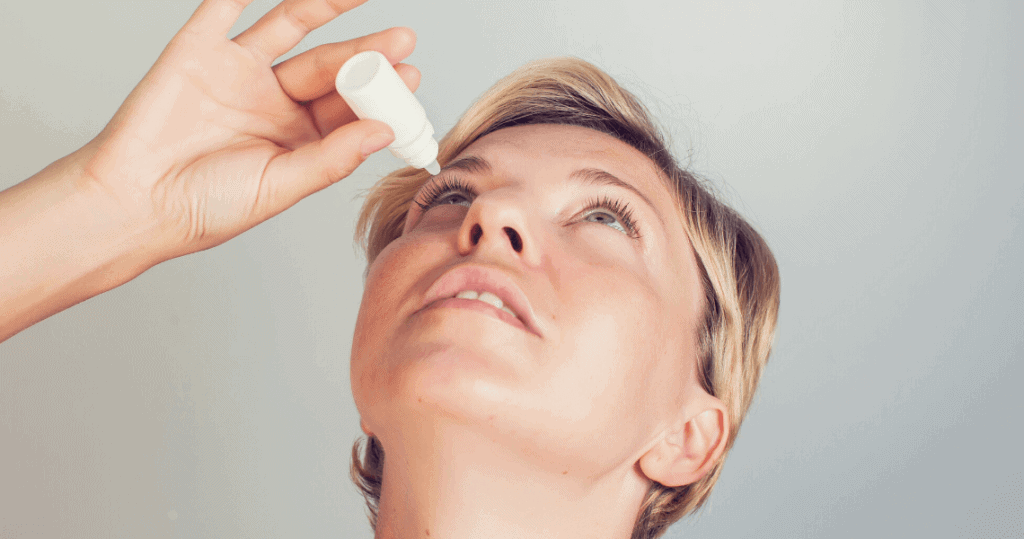Dry eye is a complex disease of the eye surface with many symptoms and causes
Dry eye is a complex disease of the eye surface with many symptoms and causes
Symptoms may include:
- Dryness, stinging, burning, itching, irritation, grittiness and even excessive tearing of the eyes
- Tired eyes, eyestrain or fluctuating vision
- Sensitivity to light, wind or airflow and smoke
- Difficulties opening eyes when waking
- Incompatibility wearing contact lenses
In some cases it may also be asymptomatic.
Common causes may include:
- Increasing age and female sex
- Systemic conditions such as Menopause or Perimenopause, Rosacea, allergies, auto-immune diseases including Thyroid and Diabetes
- Medications such as antihistamines and antidepressants
- Extended periods of screen time
- Previous eye surgery or contact lens use
Dry eye factors:
Poor tear quality.
Poor tear production.
Poor blinking leading to increased tear film evaporation and an unstable tear film surface.
Imbalance of the bacteria around the eye, known as Blepharitis.

Treatments

Lubricating products
Lubricating eye drops, gels or ointments hydrate the eye surface and are suitable for mild to moderate dry eye. They improve symptoms but are unable to treat the underlying causes in the long term. Different formulas are targeted to help different types of dry eye.
Anti-inflammatory Medications
Anti-inflammatory medications may be necessary in some cases, as inflammation is a significant factor of dry eye disease. Some anti-inflammatory medications may be available over the counter or with a prescription and steroidal or immunosuppressant in nature. It is important to follow directions for these treatments carefully as some may have adverse effects if used long term or incorrectly.
Heat Pack & Intense Pulsed Light (IPL) Treatments
Treatments to stimulate the eyelid (Meibomian) glands increase tear quality and production. At home this can be performed with microwavable or electronic heat eye masks which directly heat and liquefy gland contents.
This can also be achieved with IPL by stimulating the glands to produce better quality tears. IPL has been established as a leading in-practice treatment for dry eye and is safe and minimally invasive. The treatment itself consists of a brief set of light flashes to the upper cheek and temples, repeated over 4 sessions. It also has an added bonus of reducing inflammation of the skin and eyelids.
Dietary Advice
Increasing Omega 3 intake can be beneficial in all types of dry eye due to their anti-inflammatory properties. It is recommended to have 1000-2000mg of Omega 3 daily, especially a type high in EPA and DHA.
Mediterranean diet, increasing B vitamin and antioxidant intake in diet may also improve dry eye disease.
Blinking Exercises
Blinking exercises increase tear secretion. They involve completely closing the eyes without squeezing the eyelids together.
Repeat this exercise a few times throughout the day.
Environmental Factors
To reduce the impact of environmental factors consider the following:
- Direct air conditioning or heating away from the eyes
- Keep hydrated
- Take frequent breaks when reading, watching TV or screen based devices
- Wear an eye mask whilst sleeping
Other Interventions
Return to see us at any time for a review and re-assessment of your dry eye symptoms and concerns.
We can refer and co-manage with our Ophthalmology colleagues or your GP for further interventions such as oral medications or to access specially compounded medications.